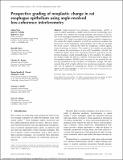Prospective grading of neoplastic change in rat esophagus epithelium using angle-resolved low-coherence interferometry
Author(s)
Wax, Adam; Pyhtila, John W.; Graf, Robert N.; Nines, Ronald; Boone, Charles W.; Feld, Michael S.; Steele, Vernon E.; Stoner, Gary D.; Dasari, Ramachandra Rao; ... Show more Show less
DownloadWax-2005-Prospective grading.pdf (839.7Kb)
PUBLISHER_POLICY
Publisher Policy
Article is made available in accordance with the publisher's policy and may be subject to US copyright law. Please refer to the publisher's site for terms of use.
Terms of use
Metadata
Show full item recordAbstract
Angle-resolved low-coherence interferometry (a/LCI) is used to obtain quantitative, depth-resolved nuclear morphology measurements. We compare the average diameter and texture of cell nuclei in rat esophagus epithelial tissue to grading criteria established in a previous a/LCI study to prospectively grade neoplastic progression. We exploit the depth resolution of a/LCI to exclusively examine the basal layer of the epithelium, approximately 50 to 100 μm beneath the tissue surface, without the need for exogenous contrast agents, tissue sectioning, or fixation. The results of two studies are presented that compare the performance of two a/LCI modalities. Overall, the combined studies show 91% sensitivity and 97% specificity for detecting dysplasia, using histopathology as the standard. In addition, the studies enable the effects of dietary chemopreventive agents, difluoromethylornithine (DFMO) and curcumin, to be assessed by observing modulation in the incidence of neoplastic change. We demonstrate that a/LCI is highly effective for monitoring neoplastic change and can be applied to assessing the efficacy of chemopreventive agents in the rat esophagus.
Date issued
2005-10Department
Massachusetts Institute of Technology. Department of Chemistry; Massachusetts Institute of Technology. Department of Physics; Massachusetts Institute of Technology. Spectroscopy LaboratoryJournal
Journal of Biomedical Optics
Publisher
SPIE
Citation
Wax, Adam, John W. Pyhtila, Robert N. Graf, Ronald Nines, Charles W. Boone, Ramachandra R. Dasari, Michael S. Feld, Vernon E. Steele, and Gary D. Stoner. “Prospective Grading of Neoplastic Change in Rat Esophagus Epithelium Using Angle-Resolved Low-Coherence Interferometry.” Journal of Biomedical Optics 10, no. 5 (2005): 051604. © 2005 Society of Photo-Optical Instrumentation Engineers
Version: Final published version
ISSN
10833668
1560-2281